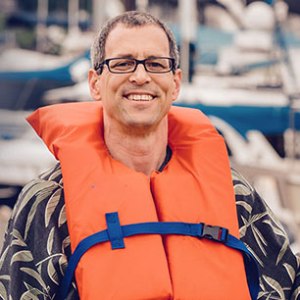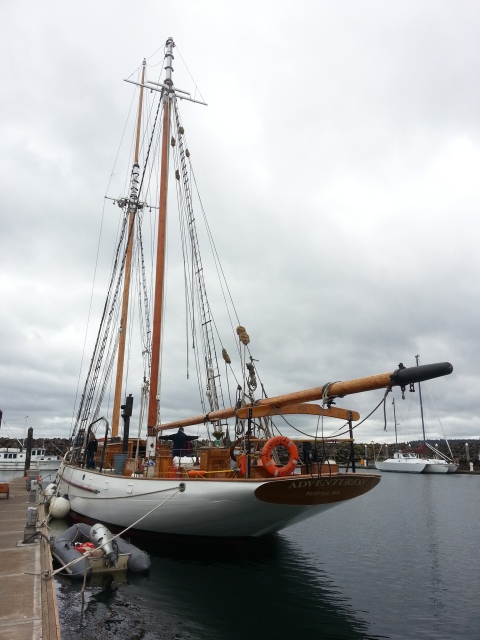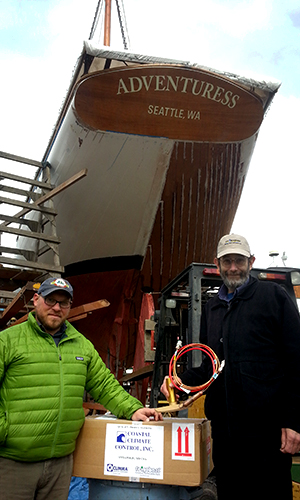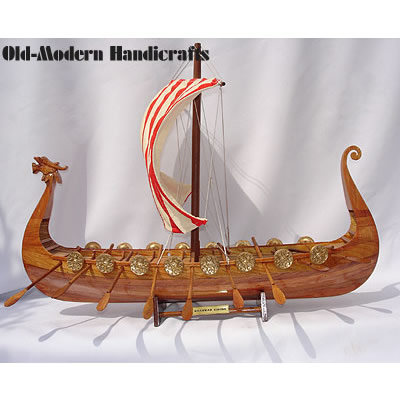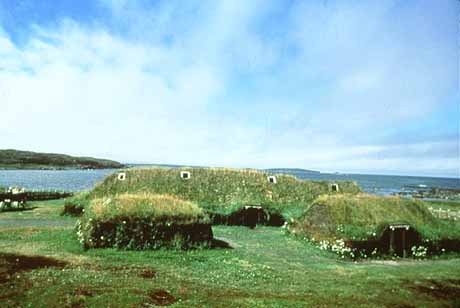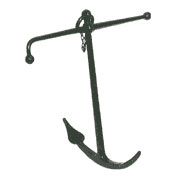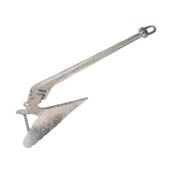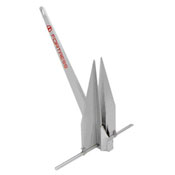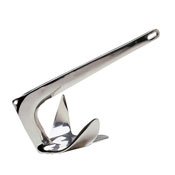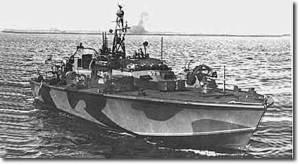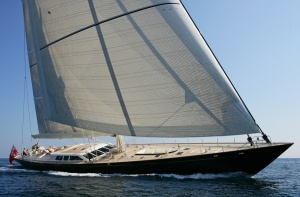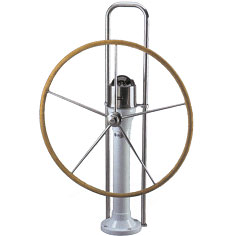“We’re on this little island in the Puget Sound, but we’re reaching boaters all around the world.”
Jeff Adams, Go2marine Operations Manager
Google recently featured Go2marine in an Economic Impact Report showing how businesses use the web and eCommerce tools to grow business and a world wide customer base.
Go2marine has called a small island in Washington State’s Puget Sound home since 1999, but does business with customers around the world. Bainbridge Island was selected as a 2013 Google eCity Award recipient for Washington state as one of the strongest online business communities.
Read what Google had to say about Go2marine here!
SHOP NOW!
Old Boat, New Tricks
May 6, 2014
The schooner Adventuress was designed by B.B. Crowninshield and built at the Rice Brothers Yard in East Boothbay, Maine. She launched in 1913; a two-masted, gaff-rigged schooner owned by John Borden II of Chicago. Borden commissioned the vessel for his personal use in the Arctic, where he planned to collect specimens including a bowhead whale skeleton for the American Museum of Natural History in New York.
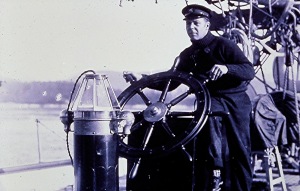
Borden’s efforts to acquire a whale never reached fruition, Adventuress was later sold to the San Francisco Bar Pilots Association where she was used as a work boat for the next 35 years.
She transferred pilots to and from cargo vessels before being commissioned during WWII as a United States Coast Guard vessel assigned to guard San Francisco Bay.
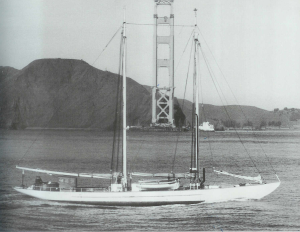 In the 1950’s, the Adventuress was brought to Seattle and the Puget Sound. In the early 1960’s, Monty Morton acquired her, restoring much of her original lines which had been altered during her years as a working boat. Her topmasts, gaff rig and bowsprit returned and the main boom was lengthened to increase her sail area. She was then used for sail training by Youth Adventures, a non-profit organization closely tied with Scouting. In the late 1980’s, Sound Experience, another educational non-profit, began conducting educational programs aboard Adventuress continuing the ship’s youth mission. In recognition of her national significance, she was listed as a National Historic Landmark in 1989.
In the 1950’s, the Adventuress was brought to Seattle and the Puget Sound. In the early 1960’s, Monty Morton acquired her, restoring much of her original lines which had been altered during her years as a working boat. Her topmasts, gaff rig and bowsprit returned and the main boom was lengthened to increase her sail area. She was then used for sail training by Youth Adventures, a non-profit organization closely tied with Scouting. In the late 1980’s, Sound Experience, another educational non-profit, began conducting educational programs aboard Adventuress continuing the ship’s youth mission. In recognition of her national significance, she was listed as a National Historic Landmark in 1989.
She is currently owned and operated by Sound Experience, a Seattle area nonprofit organization who’s mission is to Educate, Inspire and Empower their community to make a difference for the future of our marine environment. Over 3,000 participants each year experience hands-on, experiential, on-the-water programs encouraging stewardship, teaching sustainability and promoting awareness of the ocean and estuarine environment.
In the past two decades alone, more than 60,000 have sailed aboard learning about the marine environment, and how their daily actions make a difference in its future. She is one of only two National Historic Landmark ships still sailing on the west coast, and one of the region’s most recognizable maritime icons.
Rig: Gaff Topsail Two-masted Schooner
Over all Length: 133 feet
Deck Length: 101 feet
Length at the Waterline: 71 feet
Beam: 21 feet
Draft: 12 feet
Rig Height: 110 feet
Sail Area: 5,478 sq. feet
Sail Number: TS15
Gross Tonnage: 98 tons
Auxiliary Engine: 250 hp diesel
Hull: Wood
Designer: B.B. Crowninshield
Commissioned: 1913
Builder: Rice Brothers East Boothbay, Maine
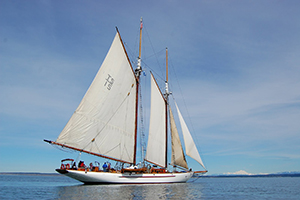 In January of 2010, Sound Experience began a $1.2 million dollar Centennial Restoration Project leading up to Adventuress’ 100th birthday in 2013.
In January of 2010, Sound Experience began a $1.2 million dollar Centennial Restoration Project leading up to Adventuress’ 100th birthday in 2013.
The project spanned a number of years and funded by grants and donations. January through April of 2010, Phase I of the restoration replaced forward port topside frames and planks (67 new futtocks and 840 feet of planking), fore chain plate, stem, fo’c’sle bunks, and anchor & headrig configuration.
Phase II & III took place November 2010 through March 2011, resulting in the re-framing of the starboard bow and the restoration of the Counter Stern. In January 2012 Phase IV began, focusing on the propeller shaft. The following November through March of 2013, the below water-line port side was re-framed.
Schooner Adventuress “Splashes” with State of the Art Refrigeration
The 101 year old gaff-rigged historic schooner Adventuress re-launched April of 2014 in Port Townsend following the completion of a $1.2 million, five year Centennial Restoration Project.
Go2marine’s Mark McBride (a leading expert on marine refrigeration) worked alongside national designers, engineers and manufacturers to design an efficient, safe and ecologically sustainable refrigeration system for the 1913 schooner. Her galley now includes a fine touch of modern convenience, new Frigoboat Keel-Cooled AC/DC Refrigeration Systems supplied by Go2marine and Coastal Climate Control, North America.
Frigoboat Marine Refrigeration, renowned world-wide as one of the best possible solutions for on-board refrigeration needs, provides a little modern day cruising comfort to a remarkable, historic vessel.
At 133 ft in vessel length, one might think the Adventuress has plenty of space in the galley for this system. Fortunately the two Frigoboat systems nested easily in the only available nook of the galley where the systems supply refrigeration to two new hand crafted 15 cubic ft lockers, one of which houses a smaller freezer.
“Once I learned of their requirements, Frigoboat was really the best choice for the Adventuress” according to Mark, who added “Coastal Climate Control is a top notch company providing support and service to the marine markets for over 25 years and this was also an important factor in choosing Frigoboat systems.” Mark goes on to say that there must be literally thousands of Frigoboat systems in the world, and Frigoboat was chosen in Practical Sailor’s (June 2009) as the winner in the “Frig Chill-off” survey.
Model Wooden Boats – Featured Ship
December 15, 2008
Go2marine is proud to carry Modern Old-World Handicrafted wooden model boats. Handicrafted models start with detailed line drawings, then scaled down for hand assembly of quality materials. These models are completely constructed, although they may require some some simple, easy assembly due to shipping with mast (or other features) folded down. From fine sailing tall ships to ocean liners to runabouts, racing yachts and canoes; there is a model to appeal to any marine affectionado.
One of the most popular model at Go2marine is the Drakkar Viking Ship. The Drake or Dragon Boat (Drakkar) is the name of the Scandinavian longboats (the dragon head, usually the ornament of the bow), sailing between 800 AD – 1050 AD. Made of oak boards laid up in clinker design.
Nothing is as symbolic of the Vikings as the longship or drakkar. Also called a dragon ship by its enemies, the drakkar was really a warship designed to carry fearless Viking warriors on their raids across Europe.
Today we have a quite clear impression of what a viking ship really is. But the vikings themselves never used the term “viking ship” about their ships. “Viking ship” is a modern term used about a whole group of different ship classes which were used in Scandinavia in the viking age (800 AD – 1050 AD) and in the next couple of centuries. We often associate the term with elegant longships with dragonheads and upright sterns and stems, and a rig with a broad square sail. Actually only a few ships were equipped with dragonheads, as they should mark the status and rank of the viking kings. The majority of the ships were more modestly decorated, optimized for sailing abilities, strength, speed and cargo capacity needed for the purpose.
Discovery of the New World
The first Europeans – the Norse, were the first foreigners to set foot in Newfoundland. Beginning in the eighth century, they burst out of their cultural homeland in Scandinavia (particularly Norway). Yet the Norse who came to Newfoundland and Labrador (in present day Canada) were not fierce raiders in search of pillage and plunder. The Norse appearance here was the final step in a relatively peaceful expansion of livestock farmers across the North Atlantic, taking in parts of the British Isles, Iceland (860 AD), Greenland (982 AD), and finally Vinland (986 AD). There is proof of a Norse habitation at L’Anse aux Meadows, in Newfoundland.
The average length of a longship was 80 feet. The largest ever excavated was over 220 feet long. Its sixty oarsmen could swiftly deliver as many as four hundred warriors to a battlefield along the coast or well inland via a river. Like most large drakkars, They were owned by a powerful king. In the last days of the Viking Age, three hundred of these longships were in the Viking fleet.
Vikings ships were rarely at the mercy of their enemies. The ships were more maneuverable, better equipped and superiorly built. They could navigate in water less than a three feet deep. In shallow water, the warriors would move to one side of the ship to tilt it so it would pass over rocks and shoals. The longships’ tapered bows and sterns enabled the Vikings to row the ships forwards and backwards without first having to turn the ships around.
The deck of a longship was completely planked over. There were no sleeping quarters below deck. Crewmen and warriors stored their personal belongings in chests on the deck. The oarsmen sat on these chests when rowing.
For more on the history of the Viking Drakkars, their explorations and lifestyle, search the internet.
Sod building replicas at L’Anse aux Meadows.
Full-scale replicas of three buildings called A, B, and C. The replicas were built a short distance away from the actual ruins in order to protect the original remains.
Anchors
May 27, 2008
No other single piece of equipment is so well discussed (and debated) by all pleasure boaters as anchors. On a given weekend, while working on deck, I have often heard somebody come by and make a comment about anchors on boats – I had a Delta 55# as my primary anchor on a 26,000# Ingrid 38 Ketch which stood out as a heavy anchor. Power boaters and sailors alike debate design, size, usage and holding power of anchors. An anchor can allow you to sleep well or it can destroy a trip or vessel. No other single piece of equipment will put a vessel in as immediate danger as when you are counting on your anchor; and your anchor fails to hold. A proper anchor will hold you to the bottom when you are drifting without a motor, while sleeping the night in a cove or weathering out a storm off a wave washed shore. An anchor also allows you to explore and overnight in places with no docks, mooring buoys; off the beaten path.
Anchor History
1300 – 1800 BC
Early anchors are thought to be rocks tied to rope and there is archaeological evidence dating from the Bronze Age to support this. For over 3000 years, anchors consisted of using a great mass to hold a vessel at anchor. In 1637, the “Sovereign of the Seas,” at 1600 tons, carried 12 anchors of 4000 pounds each! It was during the 1600’s that two goals were combined to make anchors what they are today, a penetrating point (from the hook) and a reasonable mass.
1846 – Kedge Anchor
The fisherman, yachtsman, or kedge, anchor works well in sand and mud, and is better in hard bottoms and grass than other anchors. The design is a non-burying type, with one arm penetrating the seabed and the other arm standing proud. The kedge anchor is popular as the ultimate storm anchor. It has stood the test of time and is still built today, in a virtually unchanged form.
1933 – Plow Anchor
Popular cruising anchors, the plow anchors include the old cruising standard CQR ‘secure’ – “Coastal Quick Release” and the modern Delta. They get their name from the plow shape witch digs in well and this anchor will reset itself if a change in pull trips it. Although it may not bury in hard bottoms, this anchor is more effective in grass than other lightweight anchors. This anchor is hard to stow, except on a bow roller.
1943 – Fluke Design
The Danforth is lightweight compared to its holding power, the Danforth is superb in sand and mud, and its flat configuration makes it easy to carry aboard. The Danforth doesn’t set well in hard bottoms, and sea grass can keep it from reaching the bottom. There are many similar lightweight fluke anchors on the market, including the Fortress, which is aluminum. In a strong current, the broad flukes of the Danforth and similar fluke anchors can make them sail through the water rather than sink to the bottom.
1970’s – Claw Anchors
Claw and Manta anchors are originally based on the Bruce anchor; the anchor designed to keep North Sea Rigs in their place. The Claw style anchor will reset itself if tripped. However, it doesn’t do well in hard bottoms, and the shape of the flukes makes it vulnerable to fouling in heavy grass. A fixed shank anchor that is harder to stow.
Since the 1970’s, private pleasure boats have driven the popularity and design of modern anchors for small to medium sized vessels. Aluminum versions of Fluke Anchors, modern fixed shank plows like the Delta and Claw are all anchors that have received and furthered designs of older proven anchors.
You will need more than one Anchor abour a boat that spends any time away from the dock.
A 34 foot cruising sailboat might carry 4 anchors; a 35# Plow anchor (main), a 33# Claw (backup), a 50# Fisherman or 40# Fluke anchor (storm) and a 8.8# grapnel (lunch hook, dingy, dredging).
For a 34 foot weekender sailboat, you could carry one 45# plow – the Delta as a main anchor and a 40# fluke as a backup anchor.
A 35 foot power boat might carry 3 anchors; a 33# stainless steel Claw (main), a 40# Fluke (backup, storm) and a small grapple or fluke anchor (lunch hook, dingy, dredging).
Careful out there!
Edson Marine Steering Systems and Pedestals
May 1, 2008
Edson Marine Steering Systems and Pedestals
Edson Corporation is one of the oldest continuously operating businesses in Massachusetts and the United States, producing boat steering wheels, marine steering pedestals and manual bilge pumps. Founded in 1859 by Jacob Edson, the Edson Corporation designs and manufactures specialty marine hardware for both commercial and pleasure boats.
Edson’s First New Beford Factory
Edson’s first, and still produced, steering system, is the 1902 Meteor worm steering system for Kaiser Wilheim’s 161’ yacht “Meteor”. This famous yacht, with its rugged Edson steering gear was Germany’s unrealized entry in the America’s Cup race.
Kaiser Wilheim’s 161’ yacht “Meteor”
Edson continued steering designs with Edson emergency steering systems being fitted to all WWI Hog Island freighters and Liberty ships. In WWII the famous Elco PT boats as well as other naval and merchant vessels are equipped with Edson emergency steering systems and Edson pumps.
Elco PT 80′ – Jungle Paint Scheme
Steering systems were to give way to Edson steering pedestals on modern personal sailboats and offshore racing sailboats, from 18′ Catalina to 152′ Baltic, and beyond. Edson installed the first steering system fitted to a fiberglass production sailboat in 1959.
Balti 152 – “Pink Gin”
Edson Steering Pedestals lead the way in small sailboat steering for anything over 20′. Edson builds a steering pedestal system for virually every production sailboat with the ability to fit to any rudder, cockpit, transom arrangement.

